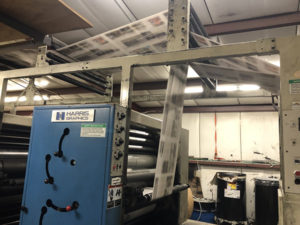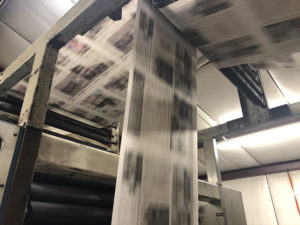By, JORDAN GREEN, Editor-in-Chief
The time is 3 a.m. After a 13-hour day working on the newspaper, I’m finally in bed.

People don’t understand how journalists “do it.” By “it,” I mean the oftentimes stressful work of writing stories, taking photos, editing stories, designing newspaper pages — and working long, late hours to get it all done.
Sometimes, even I don’t understand how I stay up into the wee hours of the night writing about the day’s events and placing those words on the pages of a newspaper — especially when the metaphorical “going” gets tough.
But every Wednesday night, I’m reminded why I love this job with all my heart.
On Wednesday, the presses roll.
The Northwestern News, Northwestern Oklahoma State University’s student newspaper, is printed by the Alva Review-Courier, one of Oklahoma’s finest family-owned newspapers.
A talented staff of reporters, advertising workers, office workers, editors and photographers assemble this outstanding community newspaper three times a week.
It’s one of the few newspapers left in this part of the country that has its own printing press. And a good one, at that — a Harris model. (I’m a Goss Community press lover myself, but Harris equipment is good.)
Once a week, the Review-Courier staff share their presses and their labor with the News. Marione Martin, the Review-Courier’s editor and publisher, as well as Jack James and David Canaan, the paper’s pressmen, are three of the best press operators this side of the Mississippi.
They don’t quit until the color registration is perfectly aligned, producing a shiny, vibrant, colorful printed product for readers to enjoy.
Marione, Jack and David are kind enough to put up with me when I ask to watch the press run. I usually ask to press the “Start” button. And they let me.
Hitting that button is more than simply firing up a machine.
For newspaper folks, pressing that button brings to life the work into which we pour our hearts.

Newspapering is hard. Every day, we newspaperfolk do our best to figure out what people need to know about.
Then we track down facts by interviewing people, reading documents (sometimes having to fight with government agencies to get them) and making our own observations as we witness events unfold — as we watch history flash before our eyes.
We gather that information, and then we try to write it.
This usually takes a few different attempts before a worthwhile story is told.
We’ll start writing, scrap the draft, and then start over. Sometimes, more than once.
We keep working the story over for as long as we can.
We’d take longer if not for deadlines. At some point, we have to finish our work and pass it on to an editor.
The editor reads our work, tries to make sense of it, and then tells us where we screwed up — and how to do better in the future.
This is an important step; a reporter is only as good as his editor, in my opinion as someone who does both jobs.
Once the editor’s done with the story, it’s sent to a designer, who uses computer software to put the story on a digital copy of a newspaper page.
The designer places photos and headlines on the page to go with the story, adjusting and readjusting all of these components over and over again until everything fits on the page.
And finally, once all of that work is done, the paper is printed. After hours and days of interviewing, writing, editing and designing, the paper is finally born.
I’ve greatly oversimplified the process. When stories aren’t finished on time, when sources don’t communicate with reporters, and when computer programs go haywire, this becomes one heck of a stressful atmosphere.
Normally, the work takes a long time — and it takes longer when the odds aren’t in one’s favor.
One must love the art of newspapering to stay in this line of work for very long. That’s something I’ve learned in my three and a half years in the business.
It’s hard, and some days, the work seems like it will never end.
But the newspaper? It is my lifeblood. It is my source of joy, completion and fulfillment. It is my reason for living.
This is my purpose in life: to inform people with fair, accurate, balanced information that can help them live better lives.
And to put those stories on the everlasting printed paper.
That paper comes to life every Wednesday in one of the least glamorous — but one of the most glorious — ceremonies known to man.
When the start button is pressed, loud rollers begin to spin.
Paper begins to weave its way through the machine, passing over metal plates and round, rubber rollers covered with sticky, gooey ink until it finally reaches a sharp cutting blade, severing one copy of the paper from another.
The machine speeds up. Press operators have to adjust it to make sure it’s printing properly.
This takes a while, and until those adjustments — the registration — are literally right on the dot, the paper doesn’t look too spiffy.
Eventually, however, everything is in order. And that colorful, wet, inky, sweet-smelling newspaper is ready to be read.

I stand by the conveyor belt carrying the papers out of the machine. I pick up the first copy as it comes off the line.
I feel the ink with my fingers, covering my hand in tones of cyan, magenta, yellow, and black — the four colors used in the printing process, also known as CMYK. I lift the paper up to my nose and take a deep breath.
Newsprint has a distinct smell; mixed with ink and water, the aroma is more beautiful than the scent of a freshly-cut hay meadow in the springtime.
All of the stress of the job melts away. I have reaped the reward for my work; I am clutching it in my bare hands.
I close my eyes, and I take a deep breath. I smile. And I remind myself: Yes, I’ve got the best job in the world.
Every Wednesday, my baby is born. The press brings it to life, and I am there, waiting to catch it.
There is no sound purer, no smell sweeter and no feeling greater than the printing of a newspaper.
I don’t bleed red. I bleed CMYK.

